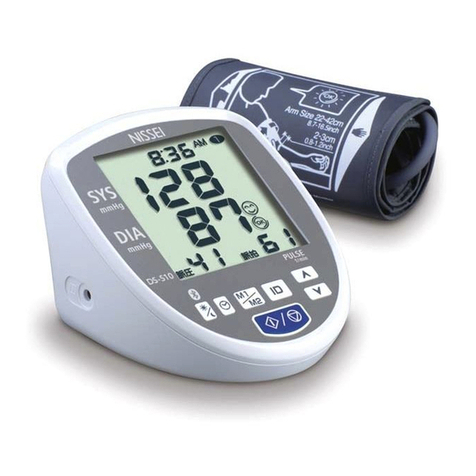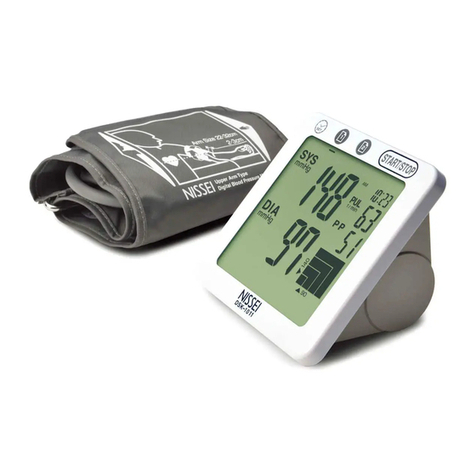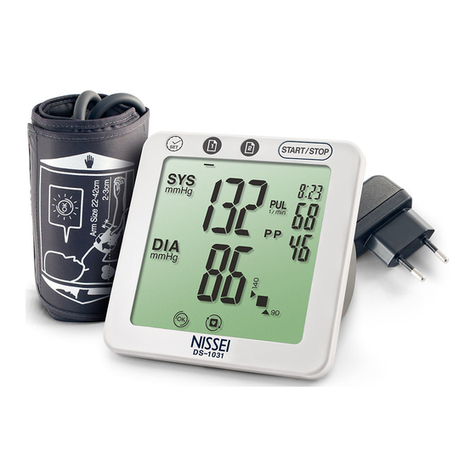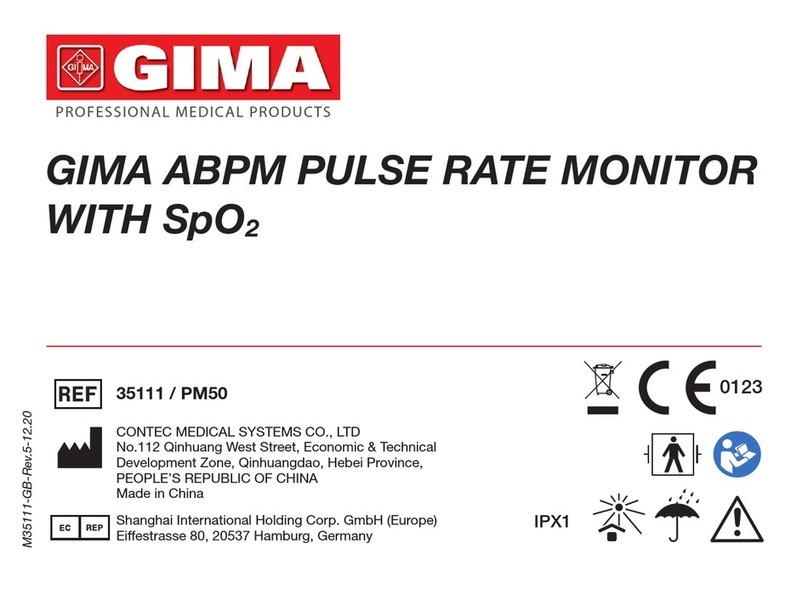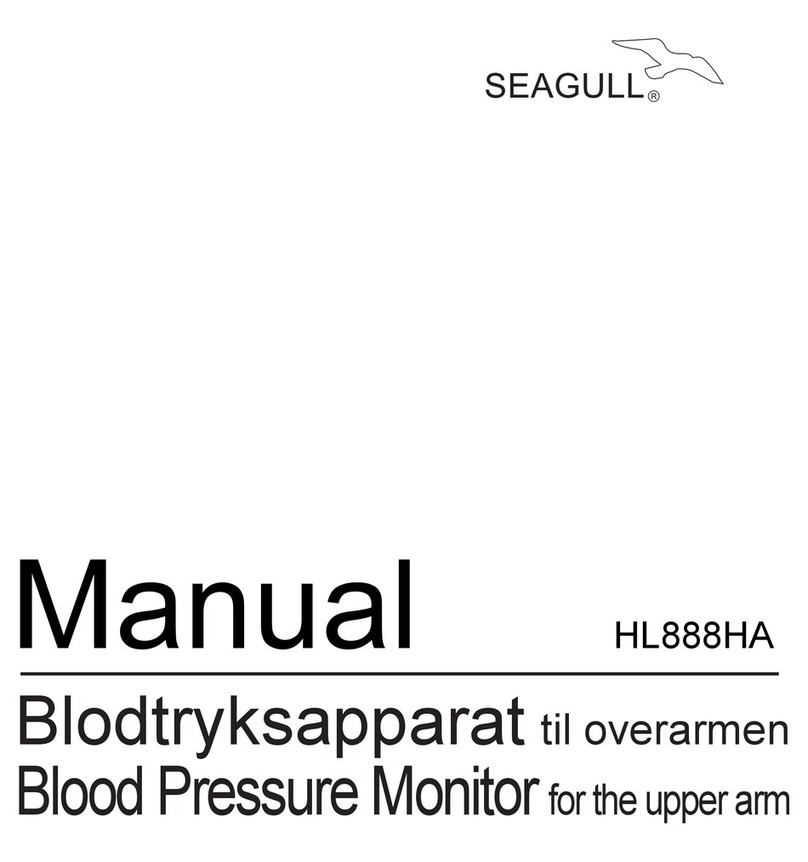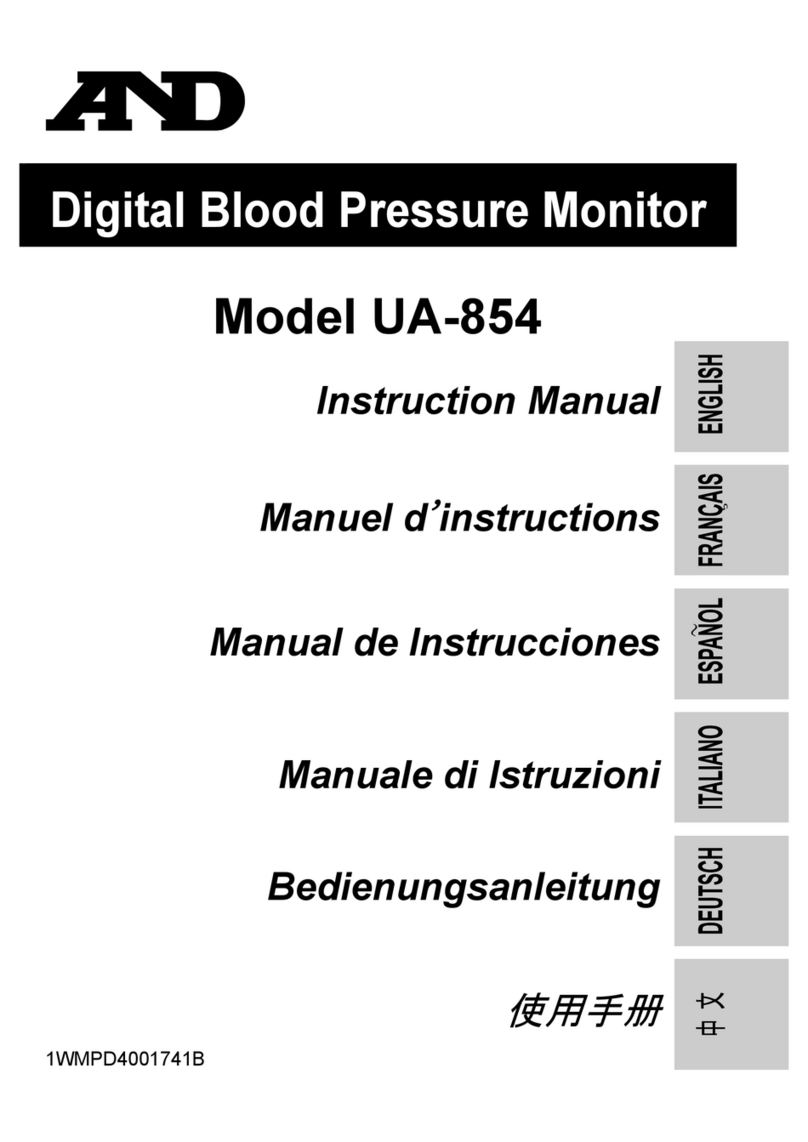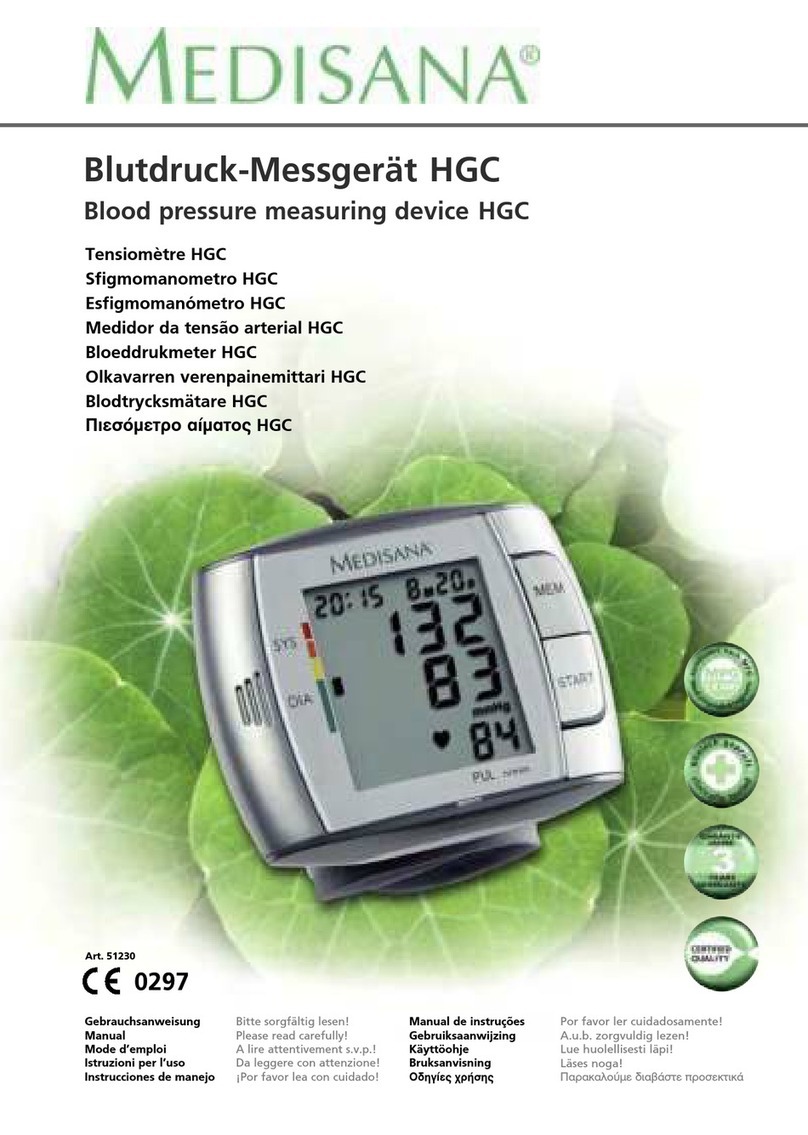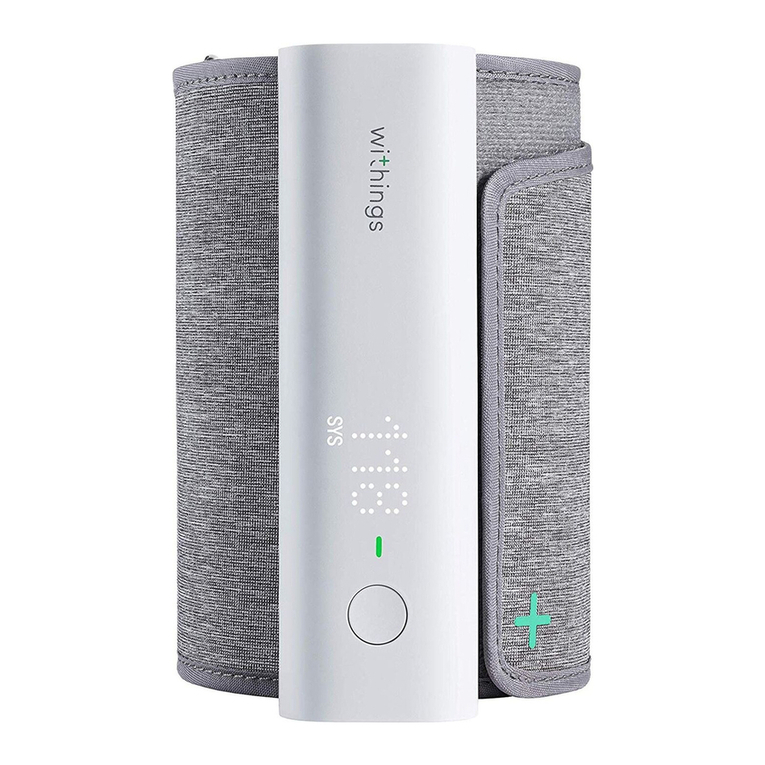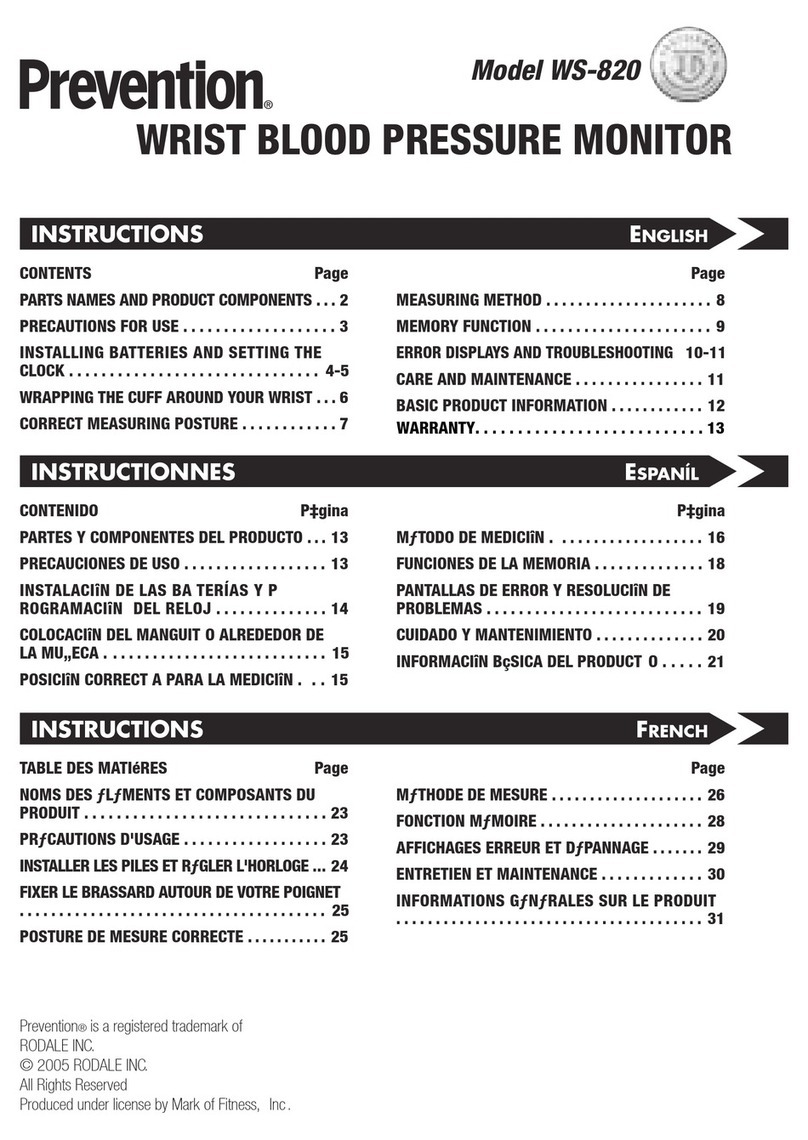Nissei WS-820 User manual

A111623-1_5
Manufacturer: NIHON SEIMITSU SOKKI CO., LTD.
2508-13 Nakago Shibukawa Gunma 377-0293 Japan
INSTRUCTIONS
ENGLISH
GEBRAUCHSANWEISUNG
DEUTSCH
INSTRUCTIONS
FRANÇAIS
ISTRUZIONI
ITALIANO
INSTRUCCIONES
ESPANÕL
INSTRUKCJA OBSŁUGI
JĘZYK POLSKI
ΟΔΗΓΙΕΣ
ΕΛΛΗΝΙΚΑ
WRIST TYPE
DIGITAL BLOOD PRESSURE MONITOR
Model WS-820

7
8 9
2
5
3
4
1
6
1display 2START button 3memory M1 button 4memory M2 button
5battery cover 6wrist cuff
82 LR03 (AAA) alkaline batteries
7carrying case 9instruction manual
1Affichage 2Bouton de démarrage 3Bouton mémoire M1
4Bouton mémoire M2 5Couvercle logement des piles 6Bracelet pour poignet
8batteries alcalines 2 x LR03 (AAA)
7Boîtier 9Manuel d’instructions
1Visualizzazioni 2Tasto START 3Tasto di memoria M1
4Tasto di memoria M2 5Coperchio del vano delle batterie 6Fascia da polso
82 x batterie alcaline LR03 (AAA)
7Custodia di trasporto 9Manuale d’uso
1display 2START-Taste 3Speichertaste M1 4Speichertaste M2
5Batteriefachdeckel 6Handgelenkmanschette
82 x LR03 (AAA) Säurebatterien
7Tragetasche 9Bedienungsanleitung
ABBILDUNGEN
PICTORIALS
ΕΙΚΟΝΕΣ
IMAGES
ILLUSTRAZIONI
FIGURAS
RESİMLER
Fig.1
PARTS NAMES AND
PRODUCT COMPONENTS
TEILEBEZEICHNUNGEN
UND
PRODUKTKOMPONENTE
N
NOMENCLATURE ET
COMPOSANTS DE
L’APPAREIL
DENOMINAZIONE DELLE
PARTI E COMPONENTI
NOMBRE DE LAS PIEZAS
Y COMPONENTES DEL
PRODCUTO
CZĘŚCI SKŁADOWE
CIŚNIENIOMIERZA
ΟΝΟΜΑΤΑ
ΑΝΤΑΛΛΑΚΤΙΚΩΝ ΚΑΙ
ΕΞΑΡΤΗΜΑΤΑ
ΠΡΟΪΟΝΤΟΣ
-2-

1.
3.
2.
AAA
1ΟΘΟΝΗ 2ΚΟΥΜΠΙ START
3ΚΟΥΜΠΙ ΜΝΗΜΗΣ M1 4ΚΟΥΜΠΙ ΜΝΗΜΗΣ Μ2
5ΚΑΛΥΜΜΑ ΜΠΑΤΑΡΙΑΣ 6ΑΣΚΟΣ ΚΑΡΠΟΥ
82 ΑΛΚΑΛΙΚΕΣ ΜΠΑΤΑΡΙΕΣ LR03 (AAA)
7ΘΗΚΗ ΜΕΤΑΦΟΡΑΣ
9ΕΓΧΕΙΡΙΔΙΟ ΟΔΗΓΙΩΝ
1pantalla 2botón START
3botón de memoria M1 4botón de memoria M2
5cubierta de pila 6puño de muñeca
82 pilas alcalinas tamaño LR03(AAA)
7caja de transporte
9manual de instrucciones
1WYŚWIETLACZ 2PRZYCISK START/STOP
3PRZYCISK PAMIĘCI M1
4PRZYCISK PAMIĘCI M2
5PRZYKRYWKA POJEMNIKA BATERII
6MANKIET NA NADGARSTEK
82 BATERIE ALKALICZNE LR03 (AAA)
7PUDEŁKO NAAPARAT
9INSTRUKCJA OBSŁUGI
fig.2
INSTALLING BATTERIES
AND SETTING THE CLOCK
page 12
EINSETZEN VON
BATTERIEN UND
EINSTELLEN DER UHR Seite
21
MISE EN PLACE DES
PILES ET RÉGLAGE DE
L’HORLOGE page 31
INSTALLAZION DELLE
BATTERIE E REGOLAZION
DELL'OROLOGIO pagina 41
INSTALACION DE PILAS Y
AJUSTE DEL RELOJ página
50
WKŁADANIE BATERII I
USTAWIANIE ZEGARA str. 59
ΤΟΠΟΘΕΤΗΣΗ
ΜΠΑΤΑΡΙΩΝ ΚΑΙ ΡΥΘΜΙΣΗ
ΡΟΛΟΓΙΟΥ σελίδα 68
-3-

M1 M2 START
increase
steigern
augmente
aumentare
aumenta
zwiększanie
αύξηση
decrease
senken
diminue
diminuire
disminuye
zmniejszanie
μείωση
confirm
bestätigen
confirme
confermare
confirme
potwierdzenie
επιβεβαίωση
4. 6.5.
7. 8.
YEAR
JAHR
ANNEE
ANNO
AÑO
ROK
ΕΤΟΣ
HOUR
STUNDE
HEURE
ORA
HORAS
GODZINA
ΏΡΑ
MONTH
MONAT
MOIS
MESE
MES
MIESIĄC
ΜΗΝΑΣ
DAY
TAG
JOUR
GIORNO
DIA
DZIEŃ
ΗΜΕΡΑ
MINUTE
MINUTEN
MINUTE
MINUTO
MINUTOS
MINUTY
ΛΕΠΤΟ
CLOCK DISPLAY
UHRANZEIGE
AFFICHAGE DE L’HORLOGE
DISPLAY DELL'OROLOGIO
INDICACION DEL RELOJ
WYŚWIETLANIE ZEGARA
ΕΝΔΕΙΞΗ ΡΟΛΟΓΙΟΥ
fig.3
WRAPPING THE CUFF
AROUND YOUR WRIST
page 12
ANLEGEN DER
MANSCHETTE AN DAS
HANDGELENK Seite 21
MISE EN PLACE DU
BRACELET SUR LE
POIGNET page 31
AVVOLGIMENTO DELLA
FASCIA AL POLSO pagina
41
ENROLLADO DEL
PUÑO ALREDEDOR DE
LA MUÑECA página 50
ZAKŁADANIE
MANKIETU NA
NADGARSTEK str. 59
ΠΕΡΙΤΥΛΙΞΗ ΤΟΥ
ΑΣΚΟΥ ΓΥΡΩ ΑΠΟ ΤΟΝ
ΚΑΡΠΟ ΣΑΣ σελίδα 69
-4-

5mm - 10mm
fig.4
CORRECT
MEASURING
POSTURE page 13
RICHTIGE HALTUNG
BEIM MESSEN Seite 22
POSITION CORRECTE
POUR LA MESURE page
32
POSIZIONE
CORRETTA DI
MISURAZIONE pagina 42
POSTURA CORRECTA
DE MEDICIÓN página 51
WŁAŚCIWA POZYCJA
W TRAKCIE POMIARU
str. 60
ΟΡΘΗ ΣΤΑΣΗ
ΜΕΤΡΗΣΗΣ σελίδα 69
-5-

relax...
entspannen...
relaxer...
rilassarsi...
relájese...
odpocznij...
χαλαρώστε…
M1 M2
START
START
1.
2. 3.
DEFLATION MARK
DEFLATIONSMARKE
MARQUE DE DÉGONFLEMENT
SIMBOLO DI SGONFIAMENTO
MARCA DE DESINFLADO
SYMBOL SPUSTU POWIETRZA
ΕΝΔΕΙΞΗ ΣΥΣΤΟΛΗΣ
INFLATION MARK
AUFBLASMARKE
MARQUE DE GONFLEMENT
SIMBOLO DI GONGIAMENTO
MARCA DE INFLADO
SYMBOL POMPOWANIA
ΕΝΔΕΙΞΗ ΔΙΑΣΤΟΛΗΣ
PULSE RATE MARK
PULSRATENMARKE
MARQUE DU POULS
SIMBOLO DEL BATTITO CARDIACO
MARCA DE RAPIDEZ DEL PULSO
SYMBOL PULSU
ΕΝΔΕΙΞΗ ΣΥΧΝΟΤΗΤΑΣ ΠΑΛΜΩΝ
fig.5
MEASURING
METHOD page 13
MESSVERFAHREN
Seite 22
MÉTHODE DE
MESURE page 32
METODO DI
MISURAZIONE
pagina 42
METODO DE
MEDICION página 51
METODA
POMIAROWA str. 60
ΜΕΘΟΔΟΣ
ΜΕΤΡΗΣΗΣ σελίδα 70
-6-

IRREGULAR PULSE
RHYTHM
UNREGELMÄSSIGER
PULSRHYTHMUS
RYTHME IRRÉGULIER DU
POULS
ARITMIA CARDIACA
RITMO DE PULSO
IRREGULAR
NIEREGULARNY RYTM
PULSU
ΑΤΑΚΤΟΣ ΣΦΥΓΜΟΣ
MEMORY BANK NUMBER
SPEICHERBANKNUMMER
NUMÉRO BANQUE DE
MÉMOIRE
NUMERO DI BANCHI DI
MEMORIA
NUMERO DE BANCO DE
MEMORIA
NUMER BANKU PAMIĘCI
ΑΡΙΘΜΟΣ ΤΡΑΠΕΖΑΣ
ΜΝΗΜΗΣ
PULSE RATE
PULSRATE
POULS
BATTITO CARDIACO
RAPIDEZ DEL PULSO
WARTOŚĆ PULSU
ΣΥΧΝΌΤΗΤΑ ΠΑΛΜΏΝ
SYSTOLIC
SYSTOLISCH
SYSTOLIQUE
SISTOLICA
SISTOLICO
SYSTOLICZNE
ΣΥΣΤΟΛΙΚΉ
DIASTOLIC
DIASTOLISCH
DIASTOLIQUE
DIASTOLICA
DIASTOLICO
DIASTOLICZNE
ΔΙΑΣΤΟΛΙΚΉ
DATE TIME SYS mmHg DIA mmHg PUL BPM
-7-

M1 M2
M1 M2
M1 M2
AVERAGE
DURCHSCHNITT
MOYENNE
MEDIA
PROMEDIO
ŚREDNIA
ΜΕΣΟΣ ΟΡΟΣ
1.
2.
3.
MEMORY DATA NUMBER
SPEICHERDATENNUMMER
NUMÉRO DES DONNÉES DE MÉMOIRE
NUMERO DI DATI IN MEMORIA
NUMERO DE DATO DE MEMORIA
NUMER BANKU PAMIĘCI
ΑΡΙΘΜΟΣ ΔΕΔΟΜΕΝΩΝ ΜΝΗΜΗΣ
TIME
ZEIT
HEURE
ORA
TIEMPO
GODZINA
ΏΡΑ
DATE
month/day
DATUM
Monat/Tag
DATE
mois/jour
DATA
mese/giorno
FECHA
mes/día
DATA
miesiàc/dzieƒ
ΗΜΕΡΟΜΗΝΙΑ
μήνας/ημέρα
fig.6
MEMORY FUNCTION
page 14
SPEICHERFUNKTION
Seite 24
FONCTION DE
MÉMOIRE page 33
FUNZIONE DI
MEMORIA pagina 43
FUNCION DE
MEMORIA página 52
FUNKCJE PAMIĘCI
str. 61
ΛΕΙΤΟΥΡΓΙΑ
ΜΝΗΜΗΣ σελίδα 71
NUMBER OF STORED DATA
ANZAHL DER GESPEICHERTEN DATEN
NUMÉRO DES DONNÉES MÉMORISÉES
NUMERO DI DATI MEMORIZZATI
NUMERO DE DATOS MEMORIZADOS
ILOŚĆ ZACHOWANYCH POMIARÓW
ΑΡΙΘΜΟΣ ΑΠΟΘΗΚΕΥΜΕΝΩΝ ΔΕΔΟΜΕΝΩΝ
-8-

METHOD OF MEASUREMENT
This product employs the oscillometric method for measurement of blood
pressure and heart rate. The entire system, including the cuff, is a single
wrist-mounted unit. The cuff is wrapped around the wrist and automatically
pressurized. Circuits within the cuff sense the small oscillations in pressure
against the cuff produced by the expansion and contraction of the arteries in
the wrist in response to each heart beat. The amplitude of each pressure
waves is measured, converted to millimeters of mercury, and displayed on the
LCD as a digital value. Responding to heart beats, the electromagnetic
INDICATIONS FOR USE
The WS-820 system is intended for the non invasive measurement of systolic
and diastolic blood pressure and determination of heart rate in adult, i.e., age
15 and above. The product is recommended for use by people with labile
(unstable) blood pressure or known hypertension in a home care environment
as an adjunct to medical management. The cuff will accommodate a wrist
circumference range of approximately 125 to 215 millimeters. Pressure is
measured over a range of 0 to 300 mmHg and heart rate over a range of 40 to
160 beats/minute.
CONTENTS
BASIC PRODUCT INFORMATION
PICTORIALS . . . . . . . . . . . . . . . . . . . . . . . . . . . . . . . . . . . . . . . . . . . . . . . 2
BASIC PRODUCT INFORMATION . . . . . . . . . . . . . . . . . . . . . . . . . . . 9
PRECAUTIONS FOR USE . . . . . . . . . . . . . . . . . . . . . . . . . . . . . . . . . 10
TIPS ON TAKING YOUR BLOOD PRESSURE . . . . . . . . . . . . . . 11
INSTALLING BATTERIES AND SETTING THE CLOCK . . . . . 12
WRAPPING THE CUFF AROUND YOUR WRIST . . . . . . . . . . . . 12
CORRECT MEASURING POSTURE . . . . . . . . . . . . . . . . . . . . . . . . 13
MEASURING METHOD . . . . . . . . . . . . . . . . . . . . . . . . . . . . . . . . . . . . 13
MEMORY FUNCTION . . . . . . . . . . . . . . . . . . . . . . . . . . . . . . . . . . . . . . 14
ERROR DISPLAYS AND TROUBLESHOOTING . . . . . . . . . . . . . 15
CARE AND MAINTENANCE . . . . . . . . . . . . . . . . . . . . . . . . . . . . . . . 16
TECHNICAL DESCRIPTION . . . . . . . . . . . . . . . . . . . . . . . . . . . . . . . 17
This manual is intended to assist the user in the safe and efficient operation of the Model WS-820 Automatic Digital Electronic Wrist Blood Pressure Monitor. The
product must be used in accordance with the procedures contained in this manual and must not be used for purposes other than those described herein. It is
important to read and understand the entire manual. In particular, please read carefully and become familiar with the section entitled “TIPS ON TAKING YOUR
BLOOD PRESSURE”.
-9-

Power Supply : 2 AAA alkaline type (LR03) dry cell
Memory : 30 measurements x 2 and averages
Applied Pressure : 190 mmHg (fixed)
Operating Environment : +10˚C to+40˚C, 85% relative humidity or below
Storage Environment : -5˚C to+50˚C, 85% relative humidity or below
Cuff : Pre-formed type cuff
Wrist circumference : Approx. 125 to 215 mm
Size : 63.5(W) x 71.0(H) x 33.0(D) mm, not including
the cuff
Weight : Approx. 100 g., without batteries
Key to symbols : Type BF equipment
: Important; Read operating instructions
Classification : Internally Powered Equipment
Specifications are subject to change without prior notice due to improvements in
performance and quality.
The user is cautioned that the system may fail to yield specified measurement
accuracy if operated or stored in temperature or humidity conditions outside the
limits stated in the specifications section of this manual.
Do not use this instrument without consultation with your doctor if you are
under dialysis therapy or on anticoagulants, antiplatelets or steroids. Use
of this instrument under such conditions could cause internal bleeding.
For specific information on your blood pressure, contact your physician.
PRECAUTIONS FOR USE
deflation control valve maintains the constant deflation rate irrespective of
differences in wrist size. A memory circuit stores the 30 most recent
measurements for comparison.
WS-820 meets the stringent requirements of German Hypertension
League to carry its quality marking.
SPECIFICATIONS
Model : WS-820
Operating Principle : Oscillometric method
Indicator : 12 digit Liquid Crystal Display
Pressure Indication Range : 0 to 300 mmHg (cuff pressure)
Measuring Range : 50 to 250 mmHg (systolic)
: 40 to 180 mmHg (diastolic)
: 40 to 160 pulses/min. (pulse rate)
Accuracy : ±3 mmHg (cuff pressure)
: ±5 % of reading (pulse rate)
Inflation : Automatic (air pump)
Deflation : Automatic (electric control valve)
Exhaust : Automatic quick exhaust valve
Never make any judgment on measurement results on your own.
Use of this device in areas near portable phones, microwave ovens or
other devices with strong electromagnetic field may cause malfunctions.
BASIC PRODUCT INFORMATION
-10-

Blood pressure is a measurement of the force exerted by the heart in pumping
the blood through the arteries and the resistance by the veins to this flow.
Blood pressure varies all the time, influenced by mental and physical
factors and is never constant.
In general, blood pressure is highest during the working hours and gradually
decreases during the afternoon and evening hours. It is low during sleep and
increases at a relatively fast rate after arising from bed.
Causes for Changes in Blood Pressure
• Body movement • Conversation • Mental Tension • Nervousness
• Emotions • Eating • Drinking Alcohol • Smoking
• Recent Urination or Bowel Movement • Temperature
• Changes in the surroundings such as movement or noise, etc.
Before taking blood pressure, rest for approximately five minutes and
take your blood pressure while relaxed in a quiet environment.
Measure blood pressure using the correct posture and do not move
nor speak during measurement.
Avoid exercise, eating, drinking alcohol, smoking and other activities
that affect your blood pressure right before a measurement.
Take your blood pressure at the same time every day.
The ambient temperature should be approximately 20˚C when you
take your blood pressure.
Blood pressure measured at home tends to be lower than when
measured in a hospital, clinic or doctor's office.
This is because you are tense at the hospital and relaxed at home. It is
important to know your stable normal blood pressure at home.
Blood pressure at the wrist may be different from that at the upper arm.
As the thickness of the blood vessels differs depending on measuring position,
blood pressure value measured at the wrist may be slightly different from that
measured at the upper arm. In most cases, the difference for a healthy person
will be within about ±10mmHg for the systolic and the diastolic blood pressure.
Caution is required for the following persons: persons with hypertension,
diabetes, liver trouble, hardened arteries, peripheral hindrance of circulation,
etc., as there may be a difference between the values measured at the wrist
and those measured at the upper arm.
Let a qualified physician interpret your blood pressure readings.
Depending on your age, weight and general condition, blood pressure can be
slightly different. Consult with your doctor on determining what blood pressure
is normal for you.
TIPS ON TAKING YOUR BLOOD PRESSURE
180~
160~179
140~159
130~139
120~129
~120
~
80
110
~
80
~
84
85
~
89
90
~
99
100
~
109
mmHg
DIA
SYS
(severe)
(moderate) Hypertension
(mild)
High Normal
Normal
Optimal
Blood pressure classification by
WHO (1999)
-11-

1. Remove the battery cover in the arrow direction.
2. Install two AAA alkaline dry cells in the battery compartment, giving
attention to their polarity.
The cells can be easily installed by pushing them while pressing their (-)
side against the spring.
CAUTION! Do not use rechargeable batteries.
3. Replace the battery cover.
4. Year flashes on the display.
Clock can be set only after the batteries are reinstalled. Setting the
clock correctly ensures storage of the measurement with the correct
date and time.
Use memory M1 button to increase the flashing year and memory M2
button to decrease the year. Press START button to confirm and move
to next step.
5. Month flashes. Adjust with M1 and M2 buttons and press START
button to confirm.
6. Day flashes. Adjust with M1 and M2 buttons and press START button
1. With the palm of your left hand up, put the cuff on your wrist so that
the display screen is on the same side as your palm.
2. Adjust the cuff, with your palm up, until its top edge is positioned 5 to
to confirm.
7. Hour flashes. Adjust with M1 and M2 buttons and press START button
to confirm. The clock operates in 24-hour mode.
8. Minute flashes. Adjust with M1 and M2 buttons and press START
button to confirm.
The clock is set and the unit is turned off.
Battery replacement indication
Replace all the batteries when the battery replacement indication appears
on the display or nothing is displayed when START button is depressed.
About 300 measurements can be made after installation of new AAA alkaline
dry cells. The enclosed batteries are for monitoring, and their life may be
shorter than that of commercial batteries.
The used electrical and electronic products are not household
waste. Follow your national/local recycling rules to dispose of
them properly. In the EU countries, please refer to waste
management symbol(s) marked on the package or the instrument.
INSTALLING BATTERIES AND SETTING THE CLOCK Fig.2 page 3
WRAPPING THE CUFF AROUND YOUR WRIST Fig.3 page 4
10 mm from the bottom of your palm. Place the unit at the center of
your wrist.
3. Fasten the cuff around your wrist so that there is no space between
-12-

To stop measurement
Press START button and the unit stops inflation, discharges air
rapidly, and then turns off.
1. Sit on a chair.
2. Lightly open your left hand, with your palm up, and put your elbow on
a table or stand.
3. Adjust the cuff to the same height as your heart with a comfortable
support such as a folded towel etc.
Hold your elbow if you do not have an appropriate table to put your
elbow on.
Breathe deeply and relax!
Make sure the cuff is wrapped correctly and it is at the same height
as your heart.
Do not move, chat or strain your arm or hand during measurement.
Measurement can be made lying on your back. Make sure that the cuff is
at the height of your heart. Reading may vary slightly, depending on
posture, whether sitting or lying.
If the cuff is lower (higher) than the heart, the measured reading
tends to become larger (smaller).
CORRECT MEASURING POSTURE
WRAPPING THE CUFF AROUND YOUR WRIST
the cuff and your wrist. The cuff should fit snugly. Press the surface of
the cuff to make sure the hook and loop attaches securely.
Position the cuff directly the skin. Take care that your clothes are not caught
by the cuff.
If it is impossible to put the cuff on your left wrist, use your right wrist for
measurement. Measurements should always be taken using the same
wrist in the same position.
Fig.4 page 5
MEASURING METHOD Fig.5 page 6
1. Press START button.
The cuff is automatically inflated to the applied pressure.
Pressure (displayed value) starts to decrease and pulse is indicated by
heart mark.
When the measurement is complete, air is automatically released from the
cuff.
Maximum and minimum blood pressures and pulse rate are displayed.
-13-

Automatic Repressurization
If the pressure applied is judged insufficient in the early phase of
measurement or if movement of the hand or wrist occurs during
measurement, the unit will inflate again to a level about 40 mmHg higher.
Automatic Repressurization is repeated until a measurement is made.
However, this does not indicate a problem.
To manually control pressurization, hold down START button immediately
after the start of inflation and release it when the pressure reaches the
level 50 mmHg higher than the expected maximum systolic pressure. If the
pressure value has exceeded 190 mmHg, the inflation will stop when the
key is released. Pressure can be increased to approximately 300 mmHg.
An example of irregular pulse
rhythm compared to regular
pulse rhythm
regular pulse rhythm
rhythm. Irregular pulse rhythm can be a
result of body movement during
measurement or can be because of
arrhythmias. Although constant
appearance of the indication under quiet
measurements may suggest arrhythmias,
do not make any judgment on your own
before consulting with your doctor.
MEASURING METHOD
MEMORY FUNCTION Fig.6 page 8
Heart mark flashes when pulse rhythm detected during measurement
was irregular.
2. Press either one of memory buttons, M1 or M2, and the result is stored
in the selected bank.
The selected memory bank number is shown on the display. The result
is stored in the bank selected when the unit is turned off. Irregular pulse
rhythm indication will not be stored, only blood pressure and pulse rate
are stored. When a measurement resulted in an error, it will not be
stored.
3. Press START button to turn off the power.
If you forget to turn off the unit, it will automatically turn off after 3 minutes.
Do not execute repeated measurements. This will cause
engorgement of the wrist and correct values will not be obtained. Let
your wrist rest for at least 5 minutes.
Irregular pulse rhythm indication
Heart mark flashing in measurement result display indicates irregular pulse
Measured result is stored in either M1 or M2. Each of two memory banks can
hold up to 30 results and their average. When the number of measurements
exceeds 30, the oldest data will be deleted to record new data. You may
decide which bank to store your measurement results to avoid data mixture
with someone else's, or may use two banks to save data measured in the
morning and evening separately.
-14-

RECALLING STORED DATA
1. Press memory M1 button or memory M2 button to see stored data.
The average of the stored result in the selected bank is displayed.
The latest result stored is displayed when there is only a single result and
the clock display remains when there are no results stored.
The memory data is displayed for approximately 30 seconds. Approximately
30 seconds after memory button is released, the apparatus will turn off.
2. Press memory button to move to next data.
The indication at the top of the display alternately changes from memory
data number to date and to time.
The memory data number 1 is the latest among the stored data in the
selected memory bank.
3. Every depression of memory button switches among the memory data.
MEMORY FUNCTION
ERROR DISPLAYS AND TROUBLESHOOTING
As memory button is pressed, the memory data number increases; the
bigger the number, the older the result.
DELETING STORED DATA
1. Show the individual result to be erased or the average of a memory
bank to clear all the memory bank data.
2. Press and hold down either one of memory buttons: M1 button to
erase specified data in memory bank M1, and M2 button to erase
specified data in memory bank M2.
The displayed data starts flashing.
3. Hold down the button until nothing but the memory bank number
is displayed.
OVER-PRESSURIZATION
The pressurization was not enough to make a measurement even
though the cuff was inflated to the maximum value because of
wrist movement or talking during measurement. Do not move
during measurement.
MEASUREMENT ERROR
Measurement could not be made because of moving or talking
during measurement. Remain still and quiet during
measurement.
INFLATION ERROR
The cuff is not properly applied. Properly apply the cuff.
If Err-2 appears after re-trying to apply the cuff properly, assume
the cuff is damaged. Contact your dealer.
DEFLATION ERROR
Movement or talking was detected during measurement. Turn off
the power and make another measurement while being quiet
and still.
-15-

Because the unit includes precision parts, care should be taken to avoid
extreme temperature variations, humidity, shock, dust, and direct sunlight. Do
not drop or strike the unit. Make sure not to expose the unit to moisture. This
unit is not water resistant.
Clean the body with a cloth moistened with water and a mild detergent, and
then wipe dry. Do not use gasoline, paint thinner, or other strong solvents.
Since the cuff may absorb perspiration and other fluids, inspect it for stain and
discoloration after each use. When cleaning the cuff, use a synthetic detergent
and gently rub the surface.
When storing the unit, do not place heavy objects on it. When the unit has
been stored at a temperature below the freezing point, keep it for at least 1
hour in a warm place before using it.
Remove the batteries if the instrument is to be stored for an extended period of
time. Keep the batteries out of reach of children.
We suggest that you have your monitor checked every 2 years. This operation
may only be performed by the manufacturer or by firms authorized by the
manufacturer.
If you cannot get correct measurement with the methods above, stop using the
unit and contact your dealer. Do not tamper with the internal mechanism. If the
unit malfunctions, please return it to the dealer or an authorized service
representative for service according to the warranty.
ERROR DISPLAYS AND TROUBLESHOOTING
CARE AND MAINTENANCES
NO DISPLAY WHEN START BUTTON IS PRESSED.
Batteries are not correctly inserted. Reinsert the batteries in the
correct position.
Battery terminals are not clean. Clean with a dry cloth.
Batteries are exhausted. Replace all batteries with new ones.
THE READING IS EXTREMELY LOW (OR HIGH). BLOOD
PRESSURE IS DIFFERENT EACH TIME.
Blood pressure readings constantly vary with time of
measurement and both mental and physical conditions. See TIPS
ON TAKING YOUR BLOOD PRESSURE.
Measurement is not taken with correct posture or the cuff is
wrapped incorrectly. Reconfirm the measurement procedures.
The reading was effected from moving or talking. Remain still
and quiet during measurement.
Measurement was taken right after exercise or other activities
influencing the reading. Measure again after resting for more
than 5 minutes. See TIPS ON TAKING YOUR BLOOD
PRESSURE.
IMPROPER OPERATION
START button was accidentally pressed during battery
replacement. Take out batteries once, reinsert them and adjust
the clock.
???
-16-

CARE AND MAINTENANCES
TECHNICAL DESCRIPTION
WS-820 complies with the EMC, electromagnetic compatibility, standard, IEC60601-1-2. Refer to the tables below for specific information regarding compliance to the standard. WS-820, as a medical electrical equipment, needs special precautions regarding EMC and needs to be installed and put into service
according to the EMC information provided below. Portable and mobile RF communications equipments can affect the device. The use of accessories other than those specified in this manual may result in increased emissions or decreased immunity of the device. WS-820 should not be used adjacent to or
stacked with other equipment.
WS-820 is intended for use in the electromagnetic environment specified below. The customer or the user of WS-820 should assure that it is used in
such an environment.
Emissions test
RF emissions CISPR 11
RF emissions CISPR 11
Harmonic emissions IEC 61000-3-2
Voltage fluctuations / flicker emissions
IEC 61000-3-3
Compliance
Group 1
Class B
N/A
N/A
Electromagnetic environment - guidance
WS-820 uses RF energy only for its internal function. Therefore, its RF emissions are very
low and are not likely to cause any interference in nearby electronic equipment.
WS-820 is suitable for use in all establishments, including domestic establishments and
those directly connected to the public low-voltage power supply network that supplies
buildings used for domestic purposes.
Table 201 - Guidance and manufacturer’s declaration - electromagnetic emissions -
WS-820 is intended for use in the electromagnetic environment specified below. The customer or the user of WS-820 should assure that it is used in
such an environment.
NOTE UTis the a.c. mains voltage prior to application of the test level.
Immunity test
Electrostatic discharge
(ESD) IEC 61000-4-2
Electrical fast transient/
burst IEC 61000-4-4
Surge IEC 61000-4-5
Voltage dips, short
interruptions and voltage
variations on power supply
input lines IEC 61000-4-11
Power frequency (50/60 Hz)
magnetic field IEC
61000-4-8
IEC 60601 test level
±6 kV contact
±8 kV air
±2 kV for power supply lines
±1 kV for input/ output lines
±1 kV differential mode
±2 kV common mode
<5% UT(>95% dip in UT) for 0,5 cycle
40% UT(60% dip in UT) for 5 cycles
70% UT(30% dip in UT) for 25 cycles
<5% UT(>95% dip in UT) for 5 sec
3 A/m
Compliance level
N/A
N/A
N/A
N/A
3 A/m
Electromagnetic environment - guidance
Floors should be wood, concrete or ceramic tile. If
floors are covered with synthetic material, the relative
humidity should be at least 30 %.
N/A
N/A
N/A
Power frequency magnetic fields should be at levels
characteristic of a typical location in a typical
commercial or hospital environment.
Table 202 - Guidance and manufacturer’s declaration - electromagnetic immunity -
WS-820 is intended for use in the electromagnetic environment specified below. The customer or the user of WS-820 should assure that it is used in
such an environment.
NOTE1 At 80 MHz and 800 MHz, the higher frequency range applies.
NOTE2 These guidelines may not apply in all situations. Electromagnetic propagation is affected by absorption and reflection from structures,
objects and people.
aField strength from fixed transmitters, such as base stations for radio (cellular/cordless) telephones and land mobile radios, amateur radio, AM and FM
radios broadcast and TV broadcast cannot be predicted theoretically with accuracy. To assess the electromagnetic environment due to fixed RF
transmitters, an electromagnetic site survey should be considered. If the measured field strength in the location in which WS-820 is used exceeds the
applicable RF compliance level above, WS-820 should be observed to verify normal operation. If abnormal performance is observed, additional measures
may be necessary, such as reorienting or relocating WS-820.
bOver the frequency range 150 kHz to 80 MHz, field strengths should be less than [V1] V/m.
Immunity test
Conducted RF
IEC 61000-4-6
Radiated RF
IEC 61000-4-3
IEC 60601 test level
3 Vrms
150 kHz to 80 MHz
3 V/m
80 MHz to 2,5 GHz
Compliance level
N/A
3 V/m
Electromagnetic environment - guidance
Portable and mobile RF communications equipment should be used no closer to any part
of WS-820, including cables, than the recommended separation distance calculated from the
equation applicable to the frequency of the transmitter.
Recommended separation distance
N/A
d=1.2√P, 80 MHz to 800 MHz d=1.2√P, 800 MHz to 2,5 GHz
Where Pis the maximum output power rating of the transmitter in watts (W)
according to the transmitter manufacturer and dis the recommended separation
distance in metres (m).
Field strengths from fixed RF transmitters, as determined by an electromagnetic site survey,a
should be less than the compliance level in each frequency range.b
Interference may occur in the vicinity of equipment marked with the following
symbol:
Table 204 - Guidance and manufacturer’s declaration - electromagnetic immunity -
WS-820 is intended for use in an electromagnetic environment in which radiated RF disturbances are controlled. The customer or the user of
WS-820 can help prevent electromagnetic interference by maintaining a minimum distance between portable and mobile RF communications
equipment (transmitters) and WS-820 as recommended below, according to the maximum output power of the communications equipment.
For transmitters rated at a maximum output power not listed above, the recommended separation distance din metres (m) can be estimated using
the equation applicable to the frequency of the transmitter, where Pis the maximum output power rating of the transmitter in watts (W) according to
the transmitter manufacturer.
NOTE1 At 80 MHz and 800 MHz, the separation distance for the higher frequency range applies.
NOTE2 These guidelines may not apply in all situations. Electromagnetic propagation is affected by absorption and reflection from structures,
objects and people.
Rated maximum output power
of transmitter, W
0,01
0,1
1
10
100
Separation distance according to frequency of transmitter m
150 kHz to 80 MHz, N/A
N/A
N/A
N/A
N/A
N/A
80 MHz to 800 MHz, d=1.2√P
0,12
0,38
1,2
3,8
12
800 MHz to 2,5 GHz, d=1.2√P
0,23
0,73
2,3
7,3
23
Table 206 - Recommended separation distances between portable and mobile RF communications equipment and WS-820 -
Do not inflate the cuff (start a measurement) when it has not been wrapped
around your wrist. Do not try to stretch or twist the cuff, and do not bring it into
contact with sharp or pointed objects.
Do not disassemble or modify the unit.
-17-

Bei diesem Produkt wird die oszillometrische Methode zur Messung von Blutdruck
und Herzfrequenz angewendet. Das gesamte System, einschließlich der
Manschette, ist ein an einem einzigen Handgelenk angebrachtes Gerät. Die
Manschette wird um das Handgelenk gewickelt und automatisch unter Druck
gesetzt. Stromkreise innerhalb der Manschette spüren die geringen Schwingungen
des Drucks gegen die Manschette, die durch Ausdehnung und Zusammenziehen
der Arterien im Handgelenk als Reaktion auf jeden Herzschlag entstehen. Die
Amplitude jeder Druckwelle wird gemessen, in Millimeter/ Quecksilber umgewandelt
und auf dem LCD als digitaler Wert angegeben. Als Reaktion auf Herzschläge
hält das elektromagnetische Auslass-Steuerungsventil die gleichbleibende
GEBRAUCHSANWEISUNG
Das System WS-820 dient der nicht-invasiven Messung des systolischen und
diastolischen Blutdrucks sowie der Bestimmung der Herzfrequenz bei erwachsenen
Patienten, d.h. bei Personen von mindestens 15 Jahren. Das Produkt wird zur
häuslichen Anwendung von Patienten mit labilem Blutdruck oder bekannter
Hypertonie empfohlen, und zwar als Ergänzung zur Betreuung durch den Hausarzt.
Die Manschette deckt einen Handgelenkumfang in einem Bereich von ca. 125 bis
215 Millimeter ab. Der Druck wird in einem Bereich von 0 bis 300 mmHg gemessen,
die Herzfrequenz in einem Bereich zwischen 40 und 160 Schlägen pro Minute.
MESSMETHODE
INHALT
GRUNDLEGENDE PRODUKTINFORMATION
ABBILDUNGEN . . . . . . . . . . . . . . . . . . . . . . . . . . . . . . . . . . . . . . . . . . . . . 2
GRUNDLEGENDE PRODUKTINFORMATION . . . . . . . . . . . . . . . 18
VORSICHTSMASSREGELN ZUR VERWENDUNG . . . . . . . . . . 19
TIPPS ZUR BLUTDRUCKMESSUNG . . . . . . . . . . . . . . . . . . . . . . . 20
EINSETZEN VON BATTERIEN UND EINSTELLEN DER UHR
. . . . . . . . . . . . . . . . . . . . . . . . . . . . . . . . . . . . . . . . . . . . . . . . . . . . . . 21
ANLEGEN DER MANSCHETTE AN DAS HANDGELENK . . .21
RICHTIGE HALTUNG BEIM MESSEN . . . . . . . . . . . . . . . . . . . . . . 22
MESSVERFAHREN . . . . . . . . . . . . . . . . . . . . . . . . . . . . . . . . . . . . . . . . 22
SPEICHERFUNKTION . . . . . . . . . . . . . . . . . . . . . . . . . . . . . . . . . . . . . 24
FEHLERANZEIGEN UND STÖRUNGSSUCHE . . . . . . . . . . . . . . 24
PFLEGE UND WARTUNG . . . . . . . . . . . . . . . . . . . . . . . . . . . . . . . . . 25
TECHNISCHE BESCHREIBUNB . . . . . . . . . . . . . . . . . . . . . . . . . . . 26
Dieses Handbuch möchte dem Anwender dabei helfen, den Automatischen Digitalen Blutdruckmonitor für das Handgelenk Modell WS-820 sicher und
wirkungsvoll zu handhaben. Das Produkt ist in Übereinstimmung mit den in diesem Handbuch enthaltenen Verfahren zu verwenden und darf nicht zu sonstigen,
hier nicht beschriebenen Zwecken verwendet werden. Lesen Sie insbesondere das Kapitel "TIPPS ZUR BLUTDRUCKMESSUNG" sorgfältig durch und machen
Sie sich mit dessen Inhalt vertraut.
-18-

Stromzufuhr : 2 pos. x AAA Säure (LR03) Trockenzellen
Speicher : 30 Messungen + Durchschnittswert x 2
Angewandter Druck : 190 mmHg (fest)
Betriebumgebung : +10˚C bis +40˚C, 85 % oder weniger
Lagerbedingungen : -5˚C bis +50˚C, 85 % oder weniger
Manschette : Vorgeformter Manschettentyp
Umfang des Handgelenks : ca. 125 bis 215 mm
Größe : 63.5(B) x 71.0(H) x 33.0(T) mm, ohne Manschette
Gewicht : ca. 100 g., ohne Batterien
Schlüssel zu den Symbolen: Ausstattung Typ BF
: Wichtiger Hinweis; Betriebsanweisungen lesen.
Klassifikation : Innerlich Angeschaltete Ausrüstung
Spezifikationen können sich ohne vorherigen Hinweis aufgrund von
Leistungs-und Qualitätsverbesserungen ändern.
Der Anwender wird darauf hingewiesen, dass das System unter Umständen
keine Messgenauigkeit erzielt, falls es bei Temperaturen oder Luftfeuchtigkeit
betrieben oder gelagert wird, die außerhalb des in den Spezifikationen dieses
Handbuchs beschriebenen Bereichs liegen.
Verwenden Sie dieses Gerät nicht ohne vorher Ihren Arzt zu konsultieren,
wenn Sie an einer Dialyse-Therapie teilnehmen oder gerinnungshemmende,
anti-blutplättchbildende oder Steroid-Medikamente einnehmen. Der Einsatz
des Geräts unter diesen Bedingungen kann innere Blutungen hervorrufen.
Wenn Sie spezielle Informationen über Ihren Blutdruck wünschen, fragen
VORSICHTSMASSREGELN ZUR VERWENDUNG
Auslassgeschwindigkeit unabhängig von irgendwelchen Unterschieden bei der
Größe des Handgelenks aufrecht. Eine Speichereinheit speichert die 30
letzten Messungen zum Vergleich.
WS-820 erfüllt die strikten Anforderungen der Deutschen LIGA zur
Bekämpfung des Bluthochdruckes (German Hypertension League),
die zur Anbringung der Qualitätsmarkierung berechtigen.
SPEZIFIKATIONEN
Modell : WS-820
Betriebsprinzip : Oszillometrische Methode
Anzeiger : 12 stellige Flüssigkristall-Anzeige
Bereich der Druckanzeige : 0 bis 300 mmHg (Manschettendruck)
Messbereich : 50 bis 250 mmHg (systolisch)
: 40 bis 180 mmHg (diastolisch)
: 40 bis 160 Pulsschläge/Min. (Pulsfrequenz)
Genauigkeit : ±3 mmHg (Manschettendruck)
: ±5% der Anzeige (Pulsfrequenz)
Aufpumpen : automatisch (Luftpumpe)
Abpumpen : automatisch (elektrisches Steuerungsventil)
Auslass : automatisches schnelles Auslassventril
Sie Ihren Arzt. Ziehen Sie niemals irgendwelche eigenen Schlüsse
aufgrund Ihrer Messergebnisse.
Die Anwendung dieses Gerätes in der Nähe von tragbaren Telefonen,
Mikrowellengeräten oder sonstiger Geräte mit starken elektromagnetischen
Feldern kann zu Fehlfunktionen führen.
GRUNDLEGENDE PRODUKTINFORMATION
-19-

Bei der Blutdruckmessung wird die Kraft, mit der das Herz das Blut durch die
Arterien pumpt und der dem Blutfluß entgegenwirkende Widerstand der Venen
gemessen.
Der Blutdruck wechselt aufgrund mentaler und körperlicher Faktoren
ständig und ist nie konstant.
Im allgemeinen ist der Blutdruck tagsüber während der normalen Arbeitszeit
am höchsten und fällt im Verlauf des Nachmittags und Abends. Im Schlaf ist
der Blutdruck niedrig und steigt nach dem Erheben vom Bett relativ schnell an.
Gründe für Veränderungen des Blutdrucks
• Körperbewegung • Unterhaltung • Mentale Spannung • Gefühle
• Mahlzeiten • Alkoholgenuss • Rauchen
• Kürzliche Urination oder Stuhlgang • Temperatur
• Änderungen in der Umgebung wie Bewegungen oder Geräusche usw.
Vorher etwa fünf Minuten ruhen und dann in ruhiger und entspannter
Umgebung den Blutdruck messen.
Den Blutdruck bei korrekter Körperhaltung messen und während der
Messung nicht sprechen und nicht bewegen.
Vermeiden Sie vor der Messung des Blutdrucks körperliche
Anstrengung, Essen, Alkoholkonsum, Rauchen und sonstige
Aktivitäten, die den Blutdruckwert beeinflussen.
Messen Sie täglich zur gleichen Uhrzeit.
Die Außentemperatur sollte während der Blutdruckmessung etwa
20°C betragen.
Der zu Hause gemessene Blutdruck ist tendenziell niedriger als der im
Krankenhaus oder in der Arztpraxis gemessene Blutdruck.
Das liegt daran, dass Sie im Krankenhaus angespannt, zu Hause aber
entspannt sind. Es ist wichtig, dass Sie Ihren stabilen normalen Blutdruck zu
Hause kennen. Blutdruckwerte geringfügig von den am Oberarm gemessenen
unterscheiden. In den meisten Fällen liegt die Differenz bei einem gesunden
Menschen in einem Bereich von ca. +10 mmHg für den systolischen und den
diastolischen Blutdruck. Bei folgenden Personen ist Vorsicht geboten:
Personen mit Hypertonie, Diabetes, Leberproblemen, verhärteten Arterien,
peripheren Durchblutungsstörungen usw.; hier kann ein Unterschied zwischen
den am Handgelenk und den am Oberarm gemessenen Werten vorliegen.
Der Blutdruck am Handgelenk kann sich von dem am Oberarm
unterscheiden.
Da die Messposition und die Dicke der Blutgefäße unterschiedlich sind,
können sich die am Handgelenk gemessenen
Lassen Sie Ihre Blutdruckwerte von einem Arzt auswerten.
Der Blutdruck kann sich in Abhängigkeit von Ihrem Alter, Gewicht und
Allgemeinzustand geringfügig unterscheiden. Ziehen Sie niemals irgendwelche
eigenen Schlüsse aufgrund Ihrer Messergebnisse.
TIPPS ZUR BLUTDRUCKMESSUNG
180~
160~179
140~159
130~139
120~129
~120
~
80
110
~
80
~
84
85
~
89
90
~
99
100
~
109
mmHg
DIA
SYS
(schwer)
(mittelschwer) Hypertonie
(leicht)
hoch normal
normal
optimal
Blutdruckeinstufung nach WHO
(1999)
-20-
Other manuals for WS-820
1
Table of contents
Languages:
Other Nissei Blood Pressure Monitor manuals

Nissei
Nissei DSK-1011 User manual

Nissei
Nissei DSK-1031 User manual
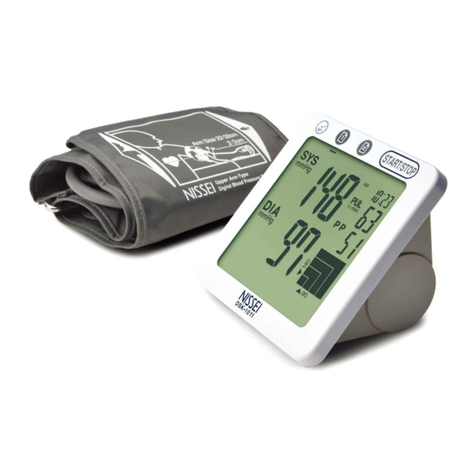
Nissei
Nissei DSK-1011 User manual
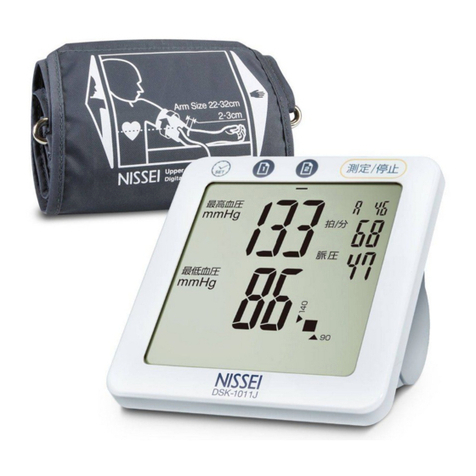
Nissei
Nissei DSK-1011J User manual
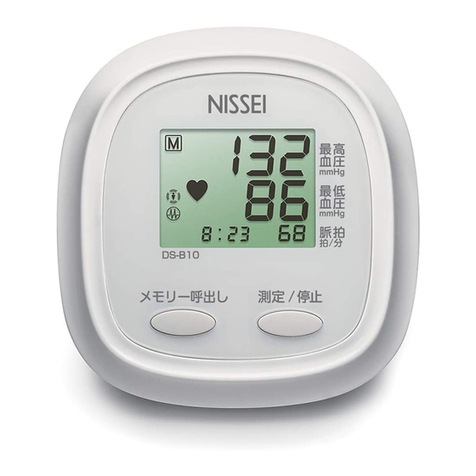
Nissei
Nissei DS-B10 User manual

Nissei
Nissei WS-1300 User manual

Nissei
Nissei WS-820 User manual
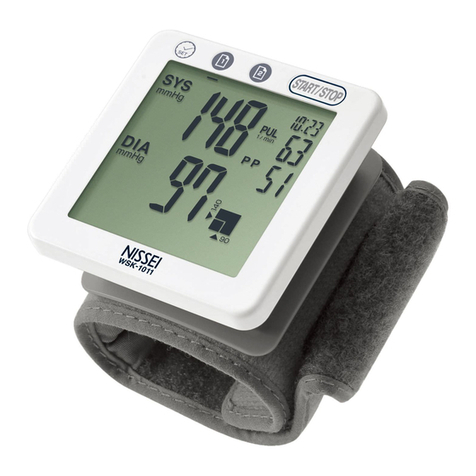
Nissei
Nissei WSK-1011 User manual
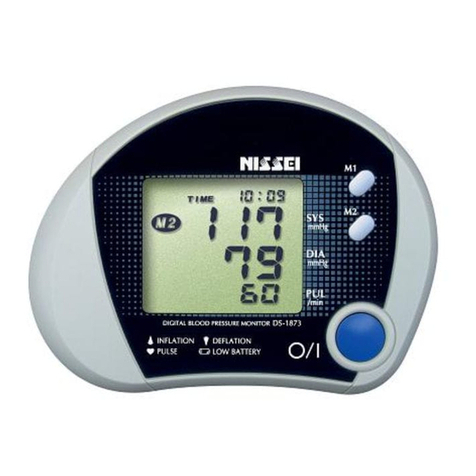
Nissei
Nissei DS-1873 User manual
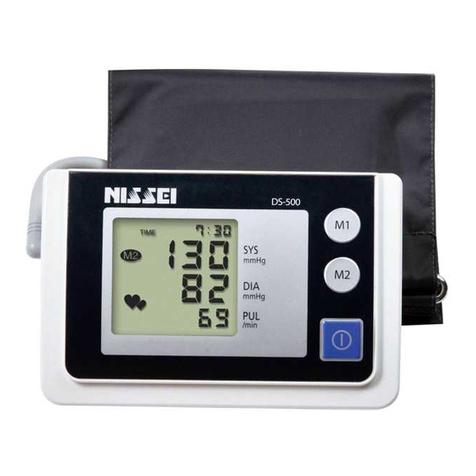
Nissei
Nissei DS-500 User manual

Nissei
Nissei WSK-1011 User manual
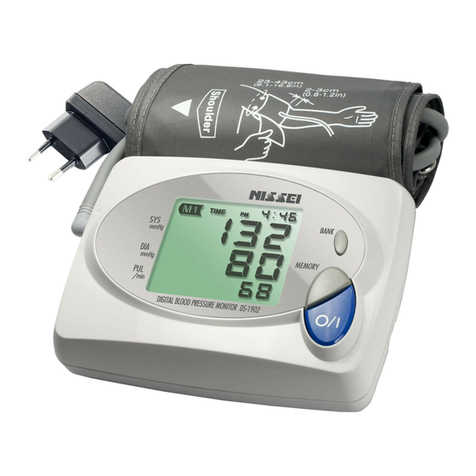
Nissei
Nissei ds-1902 User manual

Nissei
Nissei DS-137 User manual

Nissei
Nissei DS-400 User manual

Nissei
Nissei DS-10 User manual
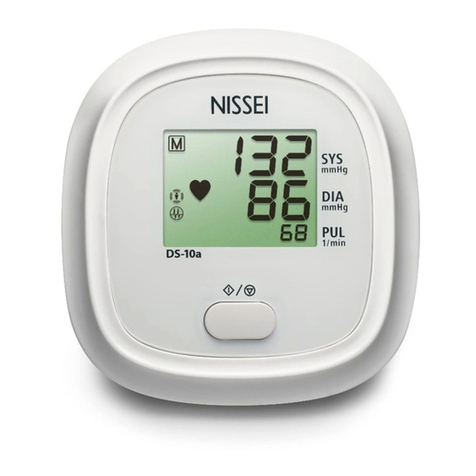
Nissei
Nissei DS-10a User manual

Nissei
Nissei DSK-1031 User manual

Nissei
Nissei WSK-1011 User manual

Nissei
Nissei DSK-1031 User manual
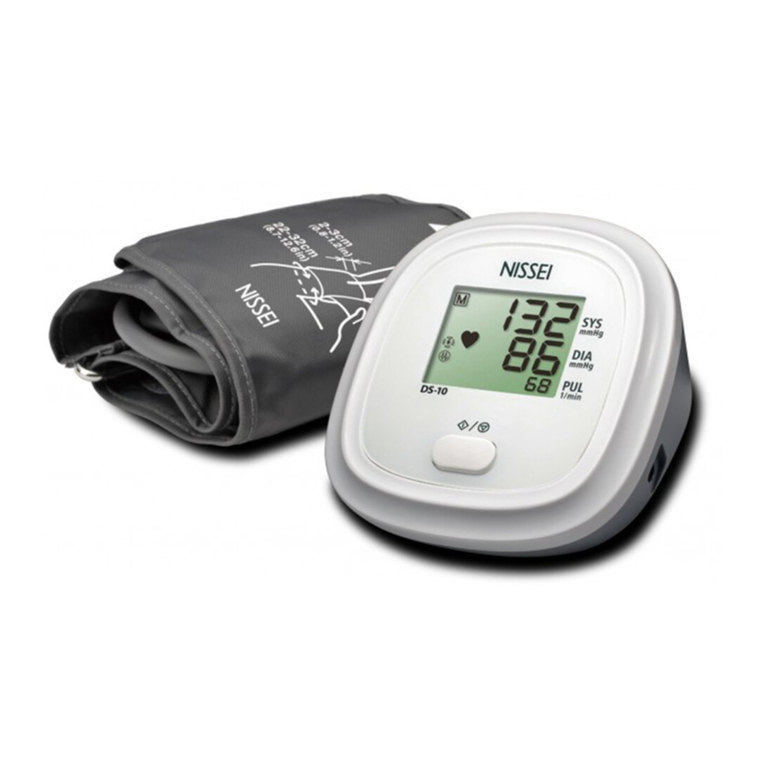
Nissei
Nissei DS-10 User manual
